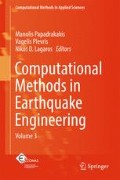Abstract
Nowadays, the design of concrete structures in Europe is governed by the application of Eurocode 2 (EC2). In particular, EC2—Part 1-1 deals with the general rules and the rules for concrete buildings. An important aspect of the design is specifying the necessary tensile (and compressive, if needed) steel reinforcement required for a Reinforced Concrete (RC) section. In this study we take into account the equivalent rectangular stress distribution for concrete and the bilinear stress-strain relation with a horizontal top branch for steel. This chapter presents three detailed methodologies for the design of rectangular cross sections with tensile reinforcement, covering all concrete classes, from C12/15 up to C90/105. The purpose of the design is to calculate the necessary tensile steel reinforcement. The first methodology provides analytic formulas and an algorithmic procedure that can be easily implemented in any programming language. The second methodology is based on design tables that are provided in Appendix A, requiring less calculations. The third methodology provides again analytic formulas that can replace the use of tables and even be used to reproduce the design tables. Apart from the direct problem, the inverse problem is also addressed, where the steel reinforcement is given and the purpose is to find the maximum bending moment that the section can withstand, given also the value and position of the axial force. For each case analytic relations are extracted in detail with a step-by-step procedure, the relevant assumptions are highlighted and results for four different cross section design examples are presented.
Access this chapter
Tax calculation will be finalised at checkout
Purchases are for personal use only
References
ACI Committee 318 (2005) Building Code Requirements for Structural Concrete (ACI 318-05) and Commentary. American Concrete Institute
Comité Euro-International du Béton (1978) CEB-FIP Model Code 1978: Model Code for Concrete Structures, 3rd ed., Lausanne
Comité Euro-International du Béton (1993) CEB-FIP Model Code 1990: Design Code. Thomas Telford, London
European Committee for Standardisation (2004) EN 1992-1-1. Eurocode 2: Design of concrete structures. Part 1-1: General rules and rules for buildings. CEN, Brussels
Fédération Internationale du Béton (2012a) fib Bulletin No. 65: Model Code 2010—Final draft, Vol. 1. FIB, Lausanne, Switzerland
Fédération Internationale du Béton (2012b) fib Bulletin No. 66: Model Code 2010—Final draft, Vol. 2. FIB, Lausanne, Switzerland
Jenkins D (2011) Time to Dump the Rectangular Stress Block? In: CONCRETE 2011 conference, Perth, Western Australia, 12–14 Oct 2011
Rüsch H (1960) Researches toward a general flexural theory for structural concrete. ACI Journal 57(7):1–28
Roşca B, Petru M (2009) Reinforced Concrete Section Design to Bending according to EN 1992-1-1/2004—Eurocode 2. Buletinul Institutului Politehnic din Iasi, Sectia V. Constructii. Arhitectura, LV (LIX)(3), 53–66
Shehata I, Shehata L, Mattos TS (2000) Stress-strain curve for the design of high-strength concrete elements. Mater Struct 33(231):411–418
Standards Australia (2009) Concrete Structures: AS 3600-2009. Sydney, Australia
Torres L, Neocleous K, Pilakoutas K (2012) Design procedure and simplified equations for the flexural capacity of concrete members reinforced with fibre-reinforced polymer bars. Structural Concrete 13(2):119–129
Walraven JC, Bigaj-van Vliet A (2011) The 2010 fib model code for structural concrete: a new approach to structural engineering. Struct Concr 12(3):139–147
Author information
Authors and Affiliations
Corresponding author
Editor information
Editors and Affiliations
Appendix A: Tables for the Design of Cross Sections with Single Reinforcement
Appendix A: Tables for the Design of Cross Sections with Single Reinforcement
Assumptions (in accordance with EC2-1-1 [4]): E s = 200 GPa and γ s = 1.15, affecting the calculation of μ sd,lim, ω lim and σ s values, only (Tables 10, 11, 12, 13, 14 and 15).
Rights and permissions
Copyright information
© 2017 Springer International Publishing AG
About this chapter
Cite this chapter
Plevris, V., Papazafeiropoulos, G. (2017). Design of RC Sections with Single Reinforcement According to EC2-1-1 and the Rectangular Stress Distribution. In: Papadrakakis, M., Plevris, V., Lagaros, N. (eds) Computational Methods in Earthquake Engineering. Computational Methods in Applied Sciences, vol 44. Springer, Cham. https://doi.org/10.1007/978-3-319-47798-5_8
Download citation
DOI: https://doi.org/10.1007/978-3-319-47798-5_8
Published:
Publisher Name: Springer, Cham
Print ISBN: 978-3-319-47796-1
Online ISBN: 978-3-319-47798-5
eBook Packages: EngineeringEngineering (R0)

